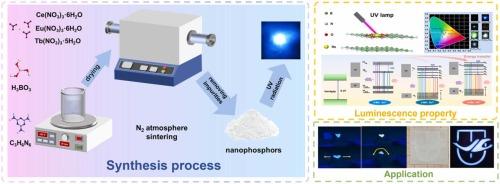Tunable color emission of boron nitride nanophosphors enabled by rare earth ions doping towards flexible luminescence application
IF 6.3
2区 材料科学
Q2 CHEMISTRY, PHYSICAL
引用次数: 0
Abstract
Luminescent materials, particularly rare-earth (RE) ion-doped phosphors, have gained significant attention due to their wide applications in optoelectronics, lighting, photovoltaics, and sensing. Hexagonal boron nitride (h-BN) is a promising host for RE ion doping owing to its remarkable properties such as ultra-wide bandgap, optical transparency, thermal stability, and inertness. However, luminescent characteristics of these activator ions in h-BN remain unclear. Herein, we successfully synthesized h-BN nanophosphors doped with RE ions (Ce3 +, Eu3 +, and Tb3 +). By adjusting the co-doping ratio, the h-BN nanophosphors exhibit bright emissions ranging from blue to green and red. White light emission was achieved at a doping ratio of [Ce3 +]/[Eu3 +]/[Tb3 +] = 1/0.2/0.2. The luminescence lifetime in h-BN nanophosphors increased by 70,000 times compared to undoped BN. Doping states of RE ions and their energy levels correlating with the luminescent transition process were elucidated through experimental results and theoretical calculations. Additionally, flexible and transparent Polydimethylsiloxane (PDMS) films based on h-BN nanophosphors were fabricated, demonstrating different colors under ultraviolet (UV) light. These polymer-based fluorescent films possess excellent stretchability without compromising their luminescent properties. This work provides a feasible and effective strategy for fabricating h-BN nanophosphors, which is significant for rigid and flexible applications like optical displays, UV detection, information encryption, and anti-counterfeiting layers.

稀土离子掺杂使氮化硼纳米荧光粉的可调色发射向着柔性发光应用
发光材料,特别是稀土离子掺杂荧光粉,由于其在光电子、照明、光伏和传感等领域的广泛应用而受到了广泛的关注。六方氮化硼(h-BN)具有超宽带隙、光学透明、热稳定性和惰性等特点,是一种很有前途的稀土离子掺杂载体。然而,这些激活离子在h-BN中的发光特性尚不清楚。在此,我们成功地合成了掺杂稀土离子(Ce3+, Eu3+和Tb3+)的h-BN纳米荧光粉。通过调整共掺杂比例,h-BN纳米荧光粉呈现出蓝色、绿色和红色的明亮发光。当掺杂比为[Ce3+]/[Eu3+]/[Tb3+] = 1/0.2/0.2时,实现了白光发射。与未掺杂的氮化硼相比,h-BN纳米荧光粉的发光寿命提高了7万倍。通过实验结果和理论计算,阐明了稀土离子的掺杂态及其与发光跃迁过程相关的能级。此外,制备了基于h-BN纳米荧光粉的柔性透明聚二甲基硅氧烷(PDMS)薄膜,在紫外线(UV)下显示出不同的颜色。这些聚合物基荧光膜具有优异的拉伸性而不影响其发光性能。这项工作为制备h-BN纳米荧光粉提供了一种可行而有效的策略,这对于光学显示、紫外线检测、信息加密和防伪层等刚性和柔性应用具有重要意义。
本文章由计算机程序翻译,如有差异,请以英文原文为准。
求助全文
约1分钟内获得全文
求助全文
来源期刊

Journal of Alloys and Compounds
工程技术-材料科学:综合
CiteScore
11.10
自引率
14.50%
发文量
5146
审稿时长
67 days
期刊介绍:
The Journal of Alloys and Compounds is intended to serve as an international medium for the publication of work on solid materials comprising compounds as well as alloys. Its great strength lies in the diversity of discipline which it encompasses, drawing together results from materials science, solid-state chemistry and physics.
 求助内容:
求助内容: 应助结果提醒方式:
应助结果提醒方式:


